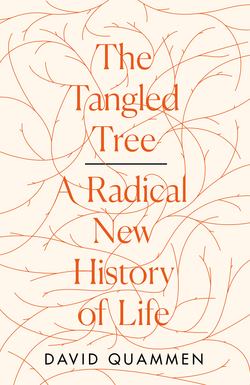Читать книгу The Tangled Tree: A Radical New History of Life - David Quammen, David Quammen - Страница 13
6
ОглавлениеBy that point, Darwin had incubated his theory in secret for half a lifetime. After sketching his little tree into the B notebook in 1837, he had continued reading, gathering facts, pondering patterns, trying out phrases, brainstorming fervidly for another sixteen months in a series of such notebooks, labeled “C” and “D” and “E,” like a man pushing puzzle pieces around on a table. Then suddenly, in November 1838, as recorded in the E notebook, he solved the puzzle of how species must evolve. Combining three pieces in his mind, he hit upon an explanatory mechanism for evolution.
The first piece was hereditary continuity. Offspring tend to resemble their parents and grandparents, providing a stable background of similarity throughout time. The second factor, a countertrend to the first, was that variation does occur. Offspring don’t precisely resemble their parents. Brown eyes, blue eyes, taller, shorter, differences of hair color or nose shape among humans; wing markings in a butterfly, beak size in a bird, length of neck in a giraffe. Reproduction is inexact. Likewise, siblings, as well as parents and offspring, differ from one another. Darwin saw that these two pieces, heredity and variation, stand together in some sort of dynamic tension.
The third puzzle piece, which he had begun considering just recently, having been alerted to it by his eclectic reading, was that population growth always tends to outrun the available means of subsistence. Earth is always getting too full of life. One female cat may give birth to five kittens; one rabbit may deliver eight bunnies; one salmon may lay a thousand eggs. If all those offspring were to survive, and reproduce in their turns, there would soon be a very great lot of cats and bunnies and salmon. Whatever the litter size, whatever the lifetime fecundity, whatever the kind of organism, including humans, we all tend to multiply by geometric progression, not just by arithmetic increase—that is, more like 2, 4, 8, 16 than like 2, 3, 4, 5. Meanwhile, living space and food supply don’t increase nearly so quickly, if at all. Habitat doesn’t replicate itself. Places get crowded. Creatures go hungry. They struggle. The result is competition and deprivation and misery, winners and losers, unsuccessful efforts to breed and, for the less fortunate individuals, early death. Many are called, but few are chosen. The book that awakened Darwin to this reality was An Essay on the Principle of Population, by a severely logical clergyman and scholar named Thomas Malthus.
Malthus’s gloomy treatise was first published in 1798. It went through six editions in the next three decades and influenced British policy on welfare. (It argued against the relatively easy charity of the contemporary Poor Laws, which were soon changed.) Darwin read it in early autumn 1838–“for amusement,” as he recalled later. Seldom is amusement more productive. He came away with the population piece, combined that with his two other pieces, and scribbled an entry in his D notebook about “the warring of the species as inference from Malthus.” Yes, this “warring” applied not just to humans, Darwin realized, but also to other creatures. Competition was fierce, and opportunities were finite. “One may say there is a force like a hundred thousand wedges,” Darwin wrote, all trying to “force every kind of adapted structure” into the gaps in the economy of nature. “The final cause of all this wedgings,” he added, “must be to sort out proper structure & adapt it to change.” By “final cause,” he essentially meant final result: the struggle yielded well-adapted forms. That was the essence, though still inchoate and crudely stated.
Darwin seemed to leave Malthus behind as he finished the D notebook, but returned to him soon in the next. That one, labeled E, begun in October 1838, was bound in rust-brown leather, with a metal clasp. It’s one of the true relics in the history of biology. In its earlier pages, Darwin ruminated further about “the grand crush of population” and alluded repeatedly to what he now called “my theory.” He was growing more confident and clear. Then, on or soon after November 27, with his usual clipped grammar and eccentric punctuation, he wrote:
Three principles, will account for all
1 Grandchildren, like, grandfathers
2 Tendency to small change … especially with physical change
3 Great fertility in proportion to support of parents
Inheritance, variation, overpopulation. He saw how they fit. Put those three together and turn the crank: you’ll get differential survival, based on something or other. Based on what? Based on which variations turn out to be most advantageous. And those variations will tend to be inherited. The result will be gradual transmutation of heritable forms, and adaptation to circumstances, by a process of selective culling. Eventually he gave the crank a name: natural selection.
Twenty years passed after the E notebook entry. The world heard nothing about natural selection.
